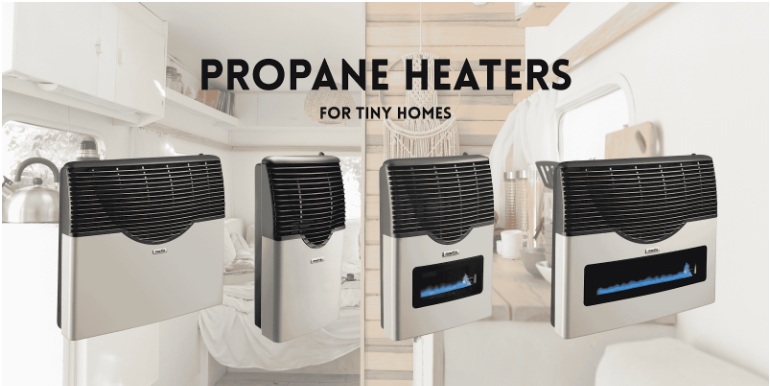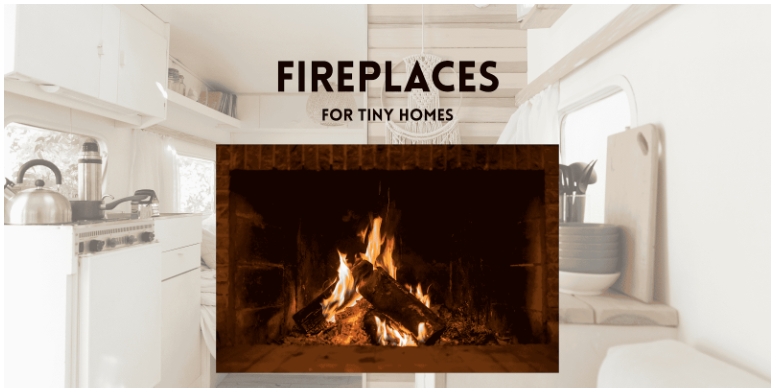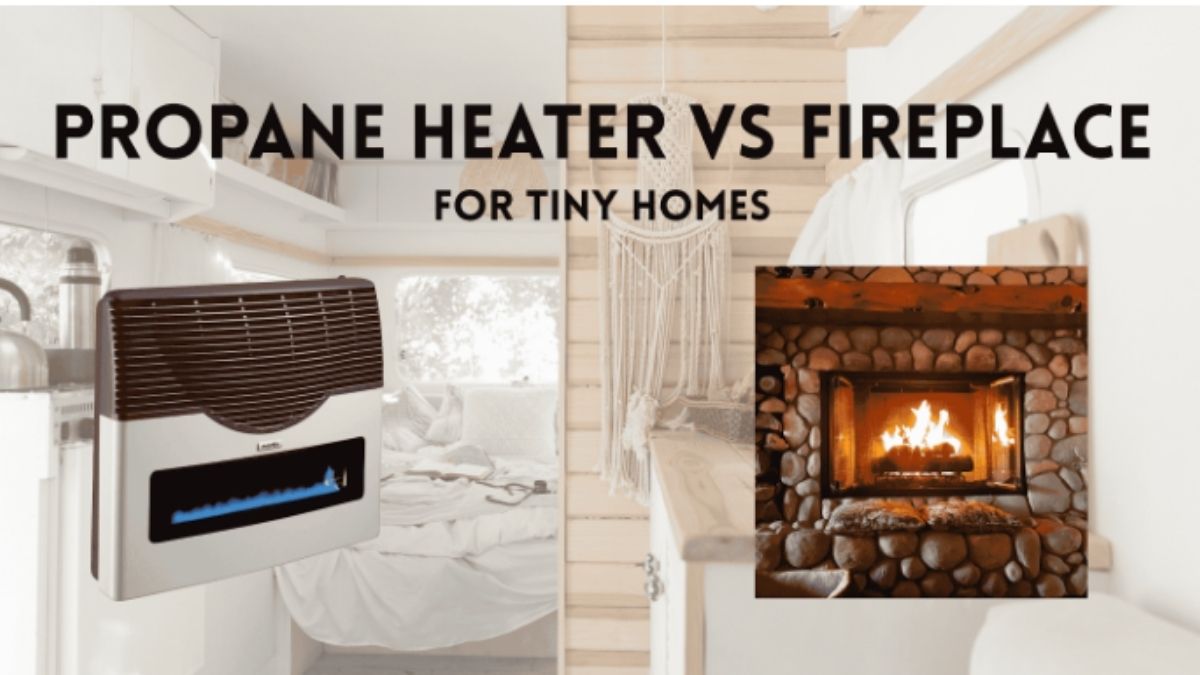Last Updated on May 15, 2025 by Kravelv Spiegel
When it comes to heating your tiny home (or any small space) efficiently, choosing the right heater can significantly impact your comfort and energy costs. Two popular options are propane heaters and wood-burning fireplaces or furnaces, and both have unique benefits and drawbacks.
We’ll extensively explore these options, helping you decide if a propane heater or a wood stove best fits your lifestyle and needs.
Why Choose a Propane Heater for Your Tiny Home?

Propane heaters are increasingly preferred for tiny homes, cabins, and compact living spaces due to their convenience, reliability, and ease of use. Modern brands, including Martin Heaters, are specifically engineered for compact living, eliminating the inconvenience of sourcing, chopping, and storing wood.
Easy to Install and Maintain
A key benefit of propane heaters is their straightforward installation. Unlike wood stoves, which often require extensive structural modifications, propane heaters need minimal alterations.
Installation typically involves mounting the heater on a wall, connecting it to a liquid propane tank, and ensuring proper outdoor venting to safely expel exhaust gases and prevent carbon monoxide accumulation. High-capacity heaters with around 12,000 BTU can effectively heat spaces of 500+ sq ft, making them suitable for many compact homes and cabins.
Maintenance for propane heaters is also relatively simple, involving routine inspections and occasional professional servicing to ensure proper functioning and safety..
Consistent and Safe Heating
Propane heaters provide reliable, consistent warmth thanks to precise thermostatic controls, allowing homeowners to set and maintain specific temperatures and avoid wasting fuel.
These heaters feature advanced safety mechanisms such as built-in shut-offs to prevent overheating and carbon monoxide leaks, making them substantially safer than portable heaters commonly used on construction sites or outdoor heaters.
This safety and reliability make propane heaters great for homes where occupants include pets, children, or the elderly.
Cheaper and More Efficient
Operating propane heaters tends to be more economical compared to fireplaces. Because propane burns efficiently, your LP tank will last longer, translating into lower fuel costs over time. Tanks are also easier and more convenient to come by than wood in most places.
Additionally, propane heaters can rapidly warm any small space, providing immediate comfort without extended waiting periods, which is especially great during Winter.
If you’re a budget-conscious homeowner, propane space heaters represent an economical and practical heating solution, delivering both affordability and comfort.
Why Choose a Wood Stove Over a Propane Heater?

Despite propane heaters’ convenience and efficiency, many tiny homeowners prefer wood stoves for their rustic charm, authentic heating experience, and independence from fossil fuels.
Warm Ambiance
The unique charm and warmth of a wood-burning fireplace or stove are unmatched. The visual appeal of dancing flames, the comforting crackle of burning wood, and the distinctive, natural heat create an inviting and cozy atmosphere difficult to replicate with propane heaters or gas log sets.
This ambiance contributes significantly to the overall comfort and enjoyment of a living space, particularly during colder months.
Sustainability
Choosing a wood stove offers independence from traditional utilities, allowing you to control your fuel source directly. This is particularly advantageous in rural or off-grid settings where sourcing wood sustainably is viable, though it does take more effort.
Furthermore, wood is a renewable and locally sourced fuel, aligning with the sustainability- and environmentally-conscious. Utilizing sustainably harvested wood reduces your environmental footprint significantly compared to fossil fuel-based heating solutions.
Installation and Maintenance Takes More Effort
Conversely, wood stoves require considerably more effort for both installation and ongoing maintenance. Proper installation involves significant initial work, including ensuring adequate clearance, chimney construction, and compliance with safety codes.
Wood stoves also demand regular maintenance, such as cleaning ash, inspecting chimneys, and managing your firewood storage. This additional labor can be burdensome for some, particularly those with limited time or have physical constraints.
Propane Heater vs Wood Stove: Practical Considerations

Propane Heater: Best for Small Spaces
For compact homes, propane heaters excel in providing substantial heat without occupying too much space. These heaters are specifically designed to be compact, efficient, and unobtrusive, preserving valuable interior space for other needs. Their sleek, modern design also complements contemporary home designs seamlessly.
Wood Stove: Meant for Larger Rooms
A significant drawback of wood stoves in small spaces is their spatial requirements. Adequate clearance from walls and furniture is necessary for safety, reducing usable interior space. This requirement can limit design flexibility and functionality within tiny homes or cabins.
Plus, portable propane heaters or natural gas heaters might be a better choice for those needing to maximize every available square foot.
Understanding BTUs and Room Size
British Thermal Units (BTUs) measure the heat output of heating devices. A general guideline is that each square foot of living space requires approximately 20 BTUs for adequate heating.
For instance, a 300 to 350 sq ft room typically needs about 8,000 BTUs. Using a heater that is too powerful can lead to excessive fuel consumption, while an underpowered heater won’t effectively warm the space.
How much fuel does a propane heater use?
On average, a 20-pound propane tank provides about 430,000 BTUs of heat. If you run a 12,000 BTU heater continuously, this tank would last approximately 36 hours. Regular monitoring of your fuel levels and scheduling tank replacements or refills is essential for uninterrupted heating, especially in colder months.
The Ideal Place to Place a Space Heater
To get the most optimal heat distribution, place your propane heater on an exterior wall near the coldest part of your room, such as near windows or doors.
Also avoid placing furniture or curtains close to the heater to reduce fire risks and to allow proper air circulation. Proper placement ensures even heat distribution and will maintain your heater’s efficiency even longer.
What propane heater should you get?
If you’ve decided that a propane heater is the one for you, Martin is well-regarded for their safety, efficiency, and for being feature-packed. To help you select the best propane heater for your tiny home, here’s a quick comparison of popular Martin propane heaters based on their heating capacity, recommended room size, and ideal use cases.
| Model | BTU | Heating Area (sq ft) | Vent Type | Thermostatic Control | Ideal Usage | |
| Martin MDV8P | 8,000 | 194 | Direct Vent | Yes | Small rooms, cabins | |
| Martin MDV12VP | 11,000 | 323 | Direct Vent | Yes | Medium-sized rooms | |
| Martin MDV20VP | 20,000 | 538 | Direct Vent | Yes | Larger spaces, open-plan areas |
Choosing the Right Heating Option for You
When it comes to heating your tiny home, cabin, or small space, both propane heaters and wood-burning stoves have clear strengths. Propane heaters stand out for their ease of installation, consistent heat output, compact design, and lower ongoing maintenance. They’re a smart choice if you’re seeking efficiency, safety, and comfort—especially when space is a priority. Martin offers a range of BTU outputs to suit any space in your home, providing dependable warmth with minimal effort.
On the other hand, wood stoves offer a timeless charm and the satisfaction of heating with a renewable, locally-sourced fuel. For those living near the woods or are desiring a more rustic experience, the natural warmth and ambiance of a wood-burning stove may be well worth the extra installation and upkeep.
Ultimately, the best choice comes down to your personal lifestyle, your space constraints, and how hands-on you want to be with your heating system. Whether you go with the convenience of a propane heater or the traditional appeal of a wood stove, both can deliver reliable heat and comfort when chosen and used wisely.
All images used in this post are owned by Wood Oak Trail and are used with full permission.

